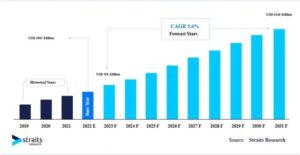Contrasting Static and Dynamic Websites: A Comprehensive Overview

In today’s digital landscape, having a strong online presence is crucial for any business or individual looking to reach a wider audience and increase their visibility. One of the key components of a successful website is its design and functionality. When it comes to website design, there are two main types: static and dynamic. While both serve the same purpose of delivering content to users, they differ in terms of features, functionality, and performance. In this blog post, we will delve into the world of static and dynamic websites, exploring their differences, advantages, and disadvantages. By the end of this post, you will have a better understanding of which type of website is best suited for your needs.
Understanding Static vs. Dynamic Websites: A Guide for Content Creators
Before we dive into the comparison between static and dynamic websites, it is important to understand what each type entails. A static website is one that is built using HTML and CSS, with fixed content that does not change unless manually updated by the website owner. On the other hand, a dynamic website uses server-side scripting languages such as PHP or ASP to generate web pages on the fly, allowing for more interactive and customizable content. Let’s take a closer look at the features and functionality of each type.
Static Websites
Static websites are typically made up of HTML files that are stored on a web server and delivered to the user’s browser as-is. This means that every time a user visits a static website, they will see the same content, regardless of when they last visited. The content on a static website is usually text-based and can include images, videos, and other multimedia elements. However, these elements are not interactive and cannot be changed without manually editing the code.
Advantages of Static Websites
- Simplicity: Static websites are easy to create and maintain, making them a popular choice for beginners or those with limited technical knowledge.
- Fast Loading Speed: Since there is no server-side processing involved, static websites load quickly, providing a seamless user experience.
- Cost-effective: Static websites do not require any additional software or server resources, making them a cost-effective option for small businesses or individuals.
Disadvantages of Static Websites
- Limited Functionality: Due to the lack of server-side scripting, static websites have limited functionality and cannot support features such as user logins, search functionality, or e-commerce capabilities.
- Manual Updates: Any changes or updates to the content of a static website must be done manually by editing the code, which can be time-consuming and tedious.
- Not Scalable: As a business grows and requires more complex features on their website, a static website may not be able to keep up with the demands.
Dynamic Websites
Dynamic websites, on the other hand, use server-side scripting to generate web pages on the fly. This means that the content on a dynamic website can change depending on various factors such as user input, time, or location. The most commonly used scripting languages for dynamic websites are PHP, ASP, and JavaScript.
Advantages of Dynamic Websites
- Interactivity: Dynamic websites allow for more interactive and engaging content, making them ideal for businesses that require user engagement, such as online stores or social media platforms.
- Customization: With server-side scripting, dynamic websites can be customized to display different content based on user preferences, making the browsing experience more personalized.
- Scalability: Dynamic websites can handle large amounts of data and can easily scale to accommodate growing businesses and their changing needs.
Disadvantages of Dynamic Websites
- Complexity: Building and maintaining a dynamic website requires advanced technical skills and knowledge, making it less accessible for beginners.
- Slower Loading Speed: Due to server-side processing, dynamic websites may take longer to load, especially if they have a large amount of data to process.
- Higher Cost: Dynamic websites require additional software and server resources, making them more expensive to build and maintain.
Static vs. Dynamic Websites: Which One is Right for Your Business?
Now that we have a better understanding of the features and functionality of static and dynamic websites, let’s take a look at which type is best suited for different types of businesses.
Small Businesses or Personal Websites
For small businesses or individuals looking to create a simple online presence, a static website would be the most suitable option. These types of websites are easy to set up and maintain, and do not require any additional costs or technical skills. They are also ideal for showcasing information about a business or individual, such as contact details, services offered, or a portfolio of work.
E-commerce Websites
For businesses that require an online store, a dynamic website would be the better choice. With its ability to support features such as user logins, search functionality, and payment gateways, a dynamic website provides a seamless shopping experience for customers. It also allows for customization and personalization, making it easier for businesses to target their audience and increase sales.
News or Blogging Websites
Dynamic websites are also well-suited for news or blogging websites. The ability to generate web pages on the fly allows for real-time updates and user engagement, making it easier for readers to stay up-to-date with the latest news and trends. Additionally, the customization options of a dynamic website make it easier for bloggers to create a unique and personalized platform for their content.
Assessing the Pros and Cons of Static and Dynamic Websites: A Comparative Analysis
To further understand the differences between static and dynamic websites, let’s take a closer look at the pros and cons of each type in a side-by-side comparison.
| Static Websites | Dynamic Websites |
|---|---|
| Simple and easy to create and maintain | Requires advanced technical skills and knowledge |
| Fast loading speed | Slower loading speed due to server-side processing |
| Cost-effective | Higher cost due to additional software and server resources |
| Limited functionality | More interactive and customizable |
| Manual updates | Real-time updates |
| Not scalable | Scalable to accommodate growing businesses |
The Role of Static and Dynamic Websites in Today’s Digital Landscape: A Comprehensive Study
In today’s digital landscape, both static and dynamic websites play a crucial role in the online presence of businesses and individuals. While static websites may seem outdated compared to their dynamic counterparts, they still have their place in the digital world. Let’s take a closer look at how each type of website is used in different industries.
Static Websites
Static websites are commonly used for informational purposes, such as displaying contact information, services offered, or company history. They are also popular among small businesses or individuals looking to establish an online presence without investing too much time or money. Additionally, static websites are often used for personal blogs or portfolios, where the focus is on the content rather than interactive features.
Dynamic Websites
Dynamic websites are widely used in e-commerce, social media, and news industries. Their ability to support user logins, search functionality, and real-time updates makes them ideal for businesses that require user engagement and interaction. They are also commonly used for online stores, where customers can browse and purchase products with ease. Social media platforms also heavily rely on dynamic websites to provide a personalized and interactive experience for their users. Lastly, news websites use dynamic websites to deliver real-time updates and engage with their readers through comments and social media integration.
Comparative Analysis of Static and Dynamic Websites: A Technical Perspective
From a technical standpoint, there are several key differences between static and dynamic websites that contribute to their performance and functionality. Let’s take a closer look at these differences.
Server-side Processing
One of the main differences between static and dynamic websites is how they handle server-side processing. Static websites do not require any server-side processing, as all the content is pre-written and stored on the web server. On the other hand, dynamic websites rely heavily on server-side processing to generate web pages on the fly, making them more complex and resource-intensive.
Database Integration
Dynamic websites often use databases to store and retrieve data, such as user information, product details, or news articles. This allows for real-time updates and customization based on user preferences. In contrast, static websites do not have database integration, as all the content is pre-written and stored in HTML files.
Content Management Systems (CMS)
Content management systems, such as WordPress or Joomla, are commonly used for dynamic websites. These platforms provide a user-friendly interface for creating and managing website content, making it easier for non-technical users to maintain their website. Static websites, on the other hand, do not require a CMS, as all the content is manually written and updated through code.
Exploring the Differences Between Static and Dynamic Websites: A Guide for Beginners
If you are new to website design and development, understanding the differences between static and dynamic websites can be overwhelming. To help you make an informed decision, here are some key points to consider when choosing between the two types of websites.
Purpose of Your Website
The first thing to consider is the purpose of your website. If you simply need an online presence to showcase information about your business or yourself, a static website would suffice. However, if you require more interactive features or e-commerce capabilities, a dynamic website would be the better option.
Technical Skills and Knowledge
Building and maintaining a dynamic website requires advanced technical skills and knowledge of scripting languages and databases. If you are a beginner or do not have the resources to hire a developer, a static website would be the more accessible option.
Budget
Static websites are generally more cost-effective than dynamic websites, as they do not require any additional software or server resources. If you have a limited budget, a static website would be the more affordable choice.
Static vs. Dynamic Websites: A Comparison of Features and Functionality
To summarize, here is a comparison of the key features and functionality of static and dynamic websites.
| Static Websites | Dynamic Websites |
|---|---|
| Simple and easy to create and maintain | More complex and resource-intensive |
| Fast loading speed | Slower loading speed due to server-side processing |
| Cost-effective | Higher cost due to additional software and server resources |
| Limited functionality | More interactive and customizable |
| Manual updates | Real-time updates |
| Not scalable | Scalable to accommodate growing businesses |
| No server-side processing | Relies on server-side processing |
| No database integration | Uses databases for real-time updates and customization |
| No CMS required | Often uses a CMS for easier content management |
Performance Evaluation of Static and Dynamic Websites: A Data-Driven Study
To further understand the differences between static and dynamic websites, let’s take a look at some performance metrics. According to a study by MachMetrics, dynamic websites have an average load time of 5.3 seconds, while static websites have an average load time of 3.2 seconds. This shows that static websites have a faster loading speed, which can greatly impact user experience and search engine rankings.
Another study by Pingdom found that dynamic websites have a higher average page size (1.9 MB) compared to static websites (0.8 MB). This is due to the additional resources required for server-side processing and database integration. However, with advancements in technology and optimization techniques, the gap between the two types of websites is becoming smaller.
Static vs. Dynamic Websites: Selecting the Optimal Solution for Your Online Presence
When it comes to choosing between static and dynamic websites, there is no one-size-fits-all solution. It ultimately depends on your specific needs and goals. If you are a small business or individual looking for a simple online presence, a static website would be the most suitable option. On the other hand, if you require more interactive features and customization, a dynamic website would be the better choice.
Conclusion
In conclusion, both static and dynamic websites have their own set of advantages and disadvantages. While static websites may seem outdated compared to dynamic websites, they still have their place in today’s digital landscape. It is important to carefully consider your needs and goals before deciding on the type of website that is best suited for your business or personal use. With the ever-evolving technology and advancements in web design, the line between static and dynamic websites is becoming more blurred. Ultimately, the key is to choose a website type that aligns with your objectives and provides the best user experience for your audience.







